As the site is updated, each listing includes the shipping cost. Some listings which I have not updated still give you calculated shipping costs based on weight and size of package. (In the sections I have updated) If you select several different listings, we will consolidate your order and charge you the actual cost of the entire package. The shipping over charge will be refunded to you, when your order is shipped.
CONE SHELLS LARGE SELECTION FOR SERIOUS AND CASUAL COLLECTORS
Cone snails, or cones, are highly venomous sea snails of the family Conidae.
Conidae, with the current common name of "cone snails", is a taxonomic family (previously subfamily) of predatory sea snails, marine gastropod molluscs in the superfamily Conoidea.
In biology, a common name of a taxon or organism (also known as a vernacular name, English name, colloquial name, country name, popular name, or farmer's name) is a name that is based on the normal language of everyday life; and is often contrasted with the scientific name for the same organism, which is often based in Latin. A common name is sometimes frequently used, but that is not always the case.
In biology, taxonomy (taxonomic is the scientific study of naming, defining (circumscribing) and classifying groups of biological organisms based on shared characteristics. Organisms are grouped into taxa (singular: taxon) and these groups are given a taxonomic rank; groups of a given rank can be aggregated to form a more inclusive group of higher rank, thus creating a taxonomic hierarchy. The principal ranks in modern use are domain, kingdom, phylum (division is sometimes used in botany in place of phylum), class, order, family, genus, and species. The Swedish botanist Carl Linnaeus is regarded as the founder of the current system of taxonomy, as he developed a ranked system known as Linnaean taxonomy for categorizing organisms and binomial nomenclature for naming organisms.
The 2014 classification of the superfamily Conoidea groups only cone snails in the family Conidae. Some previous classifications grouped the cone snails in a subfamily, Coninae.
As of March 2015 Conidae contained over 800 recognized species. Working in 18th-century Europe, Carl Linnaeus knew of only 30 species that are still considered valid.
The snails within this family are sophisticated predatory animals. They hunt and immobilize prey using a modified radular tooth along with a venom gland containing neurotoxins; the tooth is launched out of the snail's mouth in a harpoon-like action.
Neurotoxins are toxins that are destructive to nerve tissue. Neurotoxins are an extensive class of exogenous chemical neurological insults that can adversely affect function in both developing and mature nervous tissue.
The radula is an anatomical structure used by mollusks for feeding, sometimes compared to a tongue. It is a minutely toothed, chitinous ribbon, which is typically used for scraping or cutting food before the food enters the esophagus.
All cone snails are venomous and capable of "stinging" humans, live cones need to be handled with caution.
There are over 900 different species of cone snails. Cone snails are typically found in warm tropical seas and oceans worldwide. They reach their greatest diversity in the Western Indo-Pacific region. While the majority of cone snails are found in warm tropical waters, some species have adapted to temperate/semi-tropical environments and are endemic to areas such as the Cape coast of South Africa, the Mediterranean, or the cool subtropical waters of southern California (Californiconus californicus).
Cone snails are found in all tropical and subtropical seas. They live on a variety of substrates, from the intertidal zone and deeper areas, to sand, rocks or coral reefs.
Cone snails have a large variety of shell colors and patterns. This variety in color and pattern has led to the creation of a large number of known synonyms and probable synonyms, making it difficult to give an exact taxonomic assignment for many snails in this genus. As of 2009, more than 3,200 different species names have been assigned, with an average of 16 new species names introduced each year.
The shells of cone snails vary in size and are conical in shape. The shell is whorled in the form of an inverted cone, with the anterior end being narrower. The protruding parts of the top of the whorls, that form the spire, are in the shape of another more flattened cone. The aperture is elongated and narrow with the sharp operculum being very small. The outer lip is simple, thin, and sharp, without a callus, and has a notched tip at the upper part. The columella is straight.
The larger species of cone snails can grow up to 9 inches in length. The shells of cone snails are often brightly colored with a variety of patterns. Some species color patterns may be partially or completely hidden under an opaque layer of periostracum. In other species, the topmost shell layer is a thin periostracum, a transparent yellowish or brownish membrane.
The periostracum is a thin, organic coating that is the outermost layer of the shell of many shelled animals, including molluscs and brachiopods.
Cone snails are carnivorous. Their prey consists of marine worms, small fish, molluscs, and other cone snails. Cone snails are slow-moving, and use a venomous harpoon to disable faster-moving prey.
The osphradium in cone snails is more specialized than in other groups of gastropods. It is through this sensory modality that cone snails are able to sense their prey. The cone snails immobilize their prey using a modified, dartlike, barbed radular tooth, made of chitin, along with a venom gland containing neurotoxins.A sensory modality is a way of sensing, like vision or hearing. Modality in someone's voice gives a sense of the person's mood.
Scientific classification
Domain: Eukaryota
Kingdom: Animalia
Phylum: Mollusca
Class: Gastropoda
Subclass: Caenogastropoda
Order: Neogastropoda
Superfamily: Conoidea
Family: Conidae
Fleming, 1822(REF: Puillandre N, Duda TF, Meyer C, Olivera BM, Bouchet P (February 2015). "One, four or 100 genera? A new classification of the cone snails". The Journal of Molluscan Studies. 81 )
(REF: Pek I, Vašíček Z, Roček Z, Hajn V, Mikuláš R (1996). Základy Zoopaleontologie [Basics of Zoopaleontology )
(REF: Franklin JB, Fernando SA, Chalke BA, Krishnan KS (2007). "Radular morphology of Conus (Gastropoda: Caenogastropoda: Conidae) from India". Molluscan Research. 27 )
(REF: Bouchet P (14 August 2011). "Conidae J. Fleming, 1822". World Register of Marine Species (WoRMS))
(REF:Bouchet P, Kantor YI, Sysoev A, Puillandre N (2011). "A new operational classification of the Conoidea". Journal of Molluscan Studies. 77 )
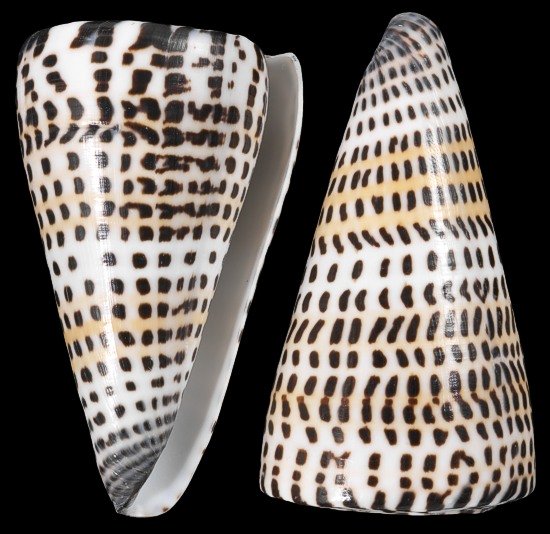
Conus spurius, commonly known as the alphabet cone or letter cone.
B1-2-3-6
One Conus spurius, commonly known as the Letter Cone Shell, measuring 3 to 4.5 inches......... OUT OF STOCK
These are species belonging to the large family of sea snails, a marine gastropod mollusk in the family Conidae.
Conus spurius snails are predatory and venomous, capable of "stinging" humans.
These marine species are found from East Florida to Venezuela; also across the West Indies.
The maximum recorded shell length is about 3 1/4 inches. The shell is white, with revolving series of spots and irregular or cloud-like markings of orange, chestnut or chocolate, often forming interrupted bands. The base of the shell is grooved. The spire shows a single broad (b>sulcus.
Sulcus is a gap where the surface of a structure is folded.
Minimum recorded depth is 0 feet to a maximum recorded depth of about 210 feet.
Scientific classification
Domain: Eukaryota
Kingdom: Animalia
Phylum: Mollusca
Class: Gastropoda
Subclass: Caenogastropoda
Order: Neogastropoda
Superfamily: Conoidea
Family: Conidae
Genus: Conus
Species: Conus spurius
Binomial name: Conus spurius
Gmelin, 1791
(REF:Conus spurius Gmelin, 1791. Retrieved through: World Register of Marine Species on 27 March 2010.)
(REF: Welch J. J. (2010). "The "Island Rule" and Deep-Sea Gastropods: Re-Examining the Evidence )
(REF: G.W. Tryon (1884) Manual of Conchology, structural and systematic, with illustrations of the species, vol. VI; Philadelphia, Academy of Natural Sciences)
(REF: Rosenberg, G.; Moretzsohn, F.; García, E. F. (2009). Gastropoda (Mollusca) of the Gulf of Mexico)
(REF:Puillandre N., Duda T.F., Meyer C., Olivera B.M. & Bouchet P. (2015). One, four or 100 genera? A new classification of the cone snails. Journal of Molluscan Studies. 81)
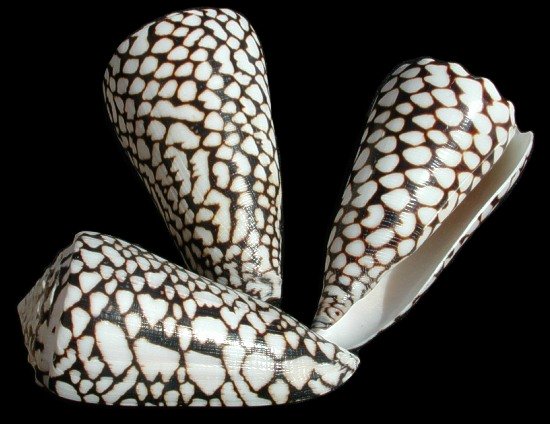
Conus marmoreus, commonly known as the marbled cone, is a species of predatory sea snail.
F0-3-17
One Conus Marmoreus, commonly known as the Marble Cone Shell, ranges in size from 2.5 to 3.5 inches........$6.99
These are predatory sea snails, a marine gastropod mollusk in the family Conidae, the cone snails, cone shells or cones. They are in the genus Conus. They primarly feed on marine mollusks including other cone snails. They, like all cone shells are venomous.
Conus marmoreus dwell in the Indian Ocean off Chagos and Madagascar, in the Bay of Bengal off India; in the western part of the Pacific Ocean to Fiji and the Marshall Islands; off Australia (Northern Territory, Queensland, Western Australia).
Adult shells can vary between 1 1/4 to 6 inches. The flattish spire is nodular. The outer lip flares towards posterior. In this species, the distinctive, reticulated color pattern can range from black with white dots, to orange with white reticulations, so arranged as to expose the white in rounded triangular large spots. The aperture is white or light pink.
Reticulation a pattern or arrangement of interlacing lines resembling a net.
Scientific classification
Domain: Eukaryota
Kingdom: Animalia
Phylum: Mollusca
Class: Gastropoda
Subclass: Caenogastropoda
Order: Neogastropoda
Superfamily: Conoidea
Family: Conidae
Genus: Conus
Species: Conus marmoreus
Binomial name: Conus marmoreus
Linnaeus, 1758
(REF: Kohn, A.; Raybaudi-Massilia, G.; Poppe, G.; Tagaro, S. (2013). "Conus marmoreus". IUCN Red List of Threatened Species. 2013)
(REF:Linnaeus, C., 1758. Systema Naturae per Regna Tria Naturae, 10th ed., 1)
(REF: Bouchet, P. (2015). Conus marmoreus Linnaeus, 1758. In: MolluscaBase (2015). Accessed through: World Register of Marine Species)
(REF: George Washington Tryon, Manual of Conchology vol. VI)
(REF:Linnaeus, C. (1758). Systema Naturae per regna tria naturae, secundum classes, ordines, genera, species, cum characteribus, differentiis, synonymis, locis. Editio decima, reformata. Laurentius Salvius: Holmiae )
(REF: Perry, G. 1811. Conchology, or the natural history of shells containing a new arrangement of the genera and species)
(REF: Tucker J.K. (2009). Recent cone species database. September 4, 2009 Edition)
(REF: Puillandre N., Duda T.F., Meyer C., Olivera B.M. & Bouchet P. (2015). One, four or 100 genera? A new classification of the cone snails. Journal of Molluscan Studies. 81)
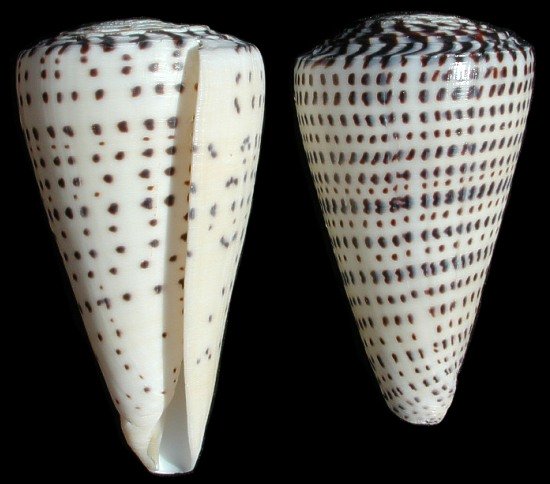
Conus leopardus, commonly known as the leopard cone, is a species of predatory sea snail.
These are predatory sea snails, a marine gastropod mollusk in the family Conidae, the cone snails, cone shells or cones. Like all species within the genus Conus, these snails are predatory and venomous.
Conus Leopardus can be found across the Indian Ocean off Aldabra, Chagos, Madagascar, the Mascarene basin, Mauritius and Tanzania; in the entire Indo-Pacific Region; off Australia (Northern Territory, Queensland, Western Australia).
The adult shell size varies between 2 to 8 3/4 inches.
Scientific classification
Domain: Eukaryota
Kingdom: Animalia
Phylum: Mollusca
Class: Gastropoda
Subclass: Caenogastropoda
Order: Neogastropoda
Superfamily: Conoidea
Family: Conidae
Genus: Conus
Species: Conus leopardus
Binomial name: Conus leopardus
(Röding, 1798)
(REF:Röding, P. F., 1798. Museum Boltenianum sive Catalogus Cimeliorum e Tribus Regnis Naturae Quae olim Collegerat Joa.., 2: I-VIII:)
(REF: WoRMS (2010). Conus leopardus (Röding, 1798). Accessed through: World Register of Marine Species)
(REF:Puillandre N., Duda T.F., Meyer C., Olivera B.M. & Bouchet P. (2015). One, four or 100 genera? A new classification of the cone snails. Journal of Molluscan Studies. 81)
CL2-17
One Leopardus Conus 2 to 3 inches.......OUT OF STOCK
CL3-17
One Leopardus Conus, 3 to 4.5 inches in size........ $9.55
These are predatory sea snails, a marine gastropod mollusk in the family Conidae, the cone snails, cone shells or cones. Like all species within the genus Conus, these snails are predatory and venomous.
Conus Leopardus can be found across the Indian Ocean off Aldabra, Chagos, Madagascar, the Mascarene basin, Mauritius and Tanzania; in the entire Indo-Pacific Region; off Australia (Northern Territory, Queensland, Western Australia).
The adult shell size varies between 2 to 8 3/4 inches.
Scientific classification
Domain: Eukaryota
Kingdom: Animalia
Phylum: Mollusca
Class: Gastropoda
Subclass: Caenogastropoda
Order: Neogastropoda
Superfamily: Conoidea
Family: Conidae
Genus: Conus
Species: Conus leopardus
Binomial name: Conus leopardus
(Röding, 1798)
(REF:Röding, P. F., 1798. Museum Boltenianum sive Catalogus Cimeliorum e Tribus Regnis Naturae Quae olim Collegerat Joa.., 2: I-VIII:)
(REF: WoRMS (2010). Conus leopardus (Röding, 1798). Accessed through: World Register of Marine Species)
(REF:Puillandre N., Duda T.F., Meyer C., Olivera B.M. & Bouchet P. (2015). One, four or 100 genera? A new classification of the cone snails. Journal of Molluscan Studies. 81)
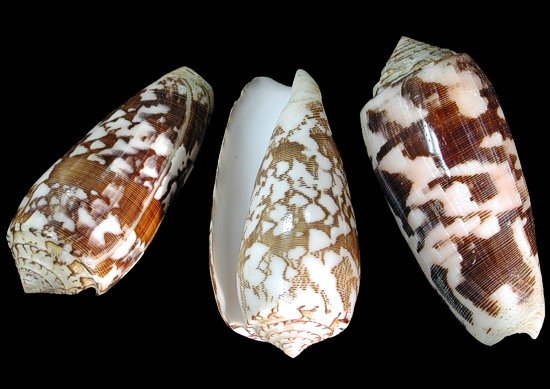
CONUS STRIATUS
E0-8
A single Conus Striatus shell, ranging in size from 3 to 4 inches........ $5.49
Conus striatus, common name the striated cone, is a species of sea snail, a marine gastropod mollusk in the family Conidae, the cone snails. These snails are predatory and venomous. They are piscivorous (eat fish).
These are relatively large, slim shells that vary in length between 1 3/4 to 5 1/4 inches. they are irregularly clouded with pink-white and chestnut or chocolate, with fine close revolving striae, forming the darker ground-color by close colored lines. The pointed spire is tessellated with chestnut or chocolate brown and white. Its shoulders are rounded and its sutures deep. The whorls are slightly channeled, carinate and striate. The outer lip shows a pronounced posterior flare.
These species dwell in the Red Sea, across the Indian Ocean off the Aldabra Atoll, Madagascar, the Mascarene Basin, Mauritius and Tanzania; in the Pacific Ocean off the Philippines, Australia (Northern Territory, Queensland, Western Australia), New Zealand, New Caledonia and Thailand. They are also found in the Hawaiian island chain.
Scientific classification
Domain: Eukaryota
Kingdom: Animalia
Phylum: Mollusca
Class: Gastropoda
Subclass: Caenogastropoda
Order: Neogastropoda
Superfamily: Conoidea
Family: Conidae
Genus: Conus
Species: Conus striatus
Binomial name: Conus striatus
Linnaeus, 1758
(REF: Duda, T. (2013). "Conus striatus". IUCN Red List of Threatened Species. 2013)
(REF: Conus striatus Linnaeus, 1758. Retrieved through: World Register of Marine Species on 27 March 2010)
(REF:Gillett, K. & McNeill, F. 1959. The Great Barrier Reef and Adjacent Isles: a comprehensive survey for visitor, naturalist and photographer. Sydney : Coral Press)
(REF: Tucker J.K. & Tenorio M.J. (2009) Systematic classification of Recent and fossil conoidean gastropods. Hackenheim: Conchbooks)
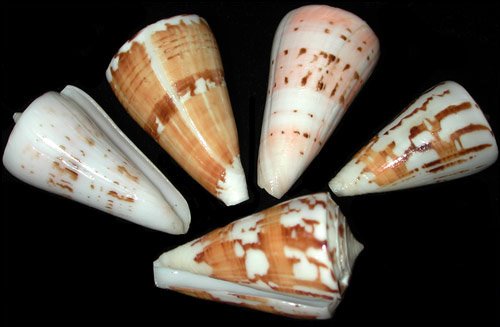
Conus generalis
CG-10
Three Conus Generalis shells, ranging from 1.5 to 2 inches in size........$5.79
Conus generalis common name is the general cone. Conus Generalis are species of sea snail, a marine gastropod mollusk in the family Conidae. These snails are predatory and venomous
The size of an adult generalis shell varies between 1 3/4 to a little more than 4 inches. Their thick, broad spire is rather plane, with a characteristic, small, acuminate (tapering to a slender point), raised apex. The color of the shell is orange-brown to chocolate, irregularly white-banded at the shoulder, in the middle, and at the base. These two or three bands are overlaid with zigzag or irregular chocolate-colored markings. The aperture is white.
Conus Generalis dwell in various shallow substrates in the Red Sea, in the Indian Ocean off Madagascar, Mauritius and Tanzania; in the Indo-West Pacific off Indonesia and the Philippines and from Northwest Australia to French Polynesia and the Ryukyu Islands; in the Central Indian Ocean along the Maldives.
Scientific classification
Domain: Eukaryota
Kingdom: Animalia
Phylum: Mollusca
Class: Gastropoda
Subclass: Caenogastropoda
Order: Neogastropoda
Superfamily: Conoidea
Family: Conidae
Genus: Conus
Species: Conus generalis
Binomial name: Conus generalis
Linnaeus, 1767
(REF: Linnaeus, C., 1767. Systema Naturae per Regna Tria Naturae, 12th ed) (REF: Conus generalis Linnaeus, 1767. Retrieved through: World Register of Marine Species on 24 July 2011.) (REF: George Washington Tryon, Manual of Conchology vol. VI) (REF: Wilson, B.R. & Gillett, K. 1971. Australian Shells: illustrating and describing 600 species of marine gastropods found in Australian waters. Sydney : Reed Books)
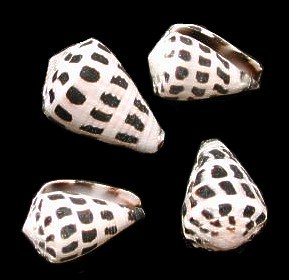
Conus ebraeus, commonly known as the black-and-white cone or Hebrew cone
CE1-17
Three Conus Ebraeus shells measuring approximately 1 inch....… $6.35
Conus ebraeus are sea snails, a marine gastropod mollusk in the family Conidae, the cone snails and their allies.
The height of the shell ranges from 1 to 2.5 inches. The width of the shell averages 3/4 inch and the height is approximately 1 inch.
Conus ebraeus are small, squat shells, with a rounded, short spire.
The Conus Abraeus shell is white, with a pattern of blackish squares, sometimes rose-tinted, with three or four revolving bands composed of irregular longitudinal dark chocolate or nearly black markings; these markings also decorate the slightly coronated spire. The aperture is white with clouded bands corresponding with the exterior markings. The surface is more or less striate throughout, but striae are more prominent towards the dark stained base.
These shells are similar to Conus judaeus. The two can be distinguished by close examination of the radular teeth.
The radula is an anatomical structure used by mollusks for feeding, sometimes compared to a tongue. It is a minutely toothed, chitinous ribbon, which is typically used for scraping or cutting food before the food enters the esophagus. The radula is unique to the mollusks, and is found in every class of mollusk except the bivalves, which instead use cilia, waving filaments that bring minute organisms to the mouth.
Conus ebraeus is one of the most widely distributed members of its genus and dwells in shallow water, tropical regions throughout the Indo-West and eastern Pacific, from the Red Sea to the shores of the Americas.
Conus ebraeus lives near rocky shores, lower eulittoral, often under boulders.
The littoral zone, also called litoral or nearshore, is the part of a sea, lake, or river that is close to the shore. In coastal ecology, the littoral zone includes the intertidal zone extending from the high water mark (which is rarely inundated), to coastal areas that are permanently submerged — known as the foreshore — and the terms are often used interchangeably. However, the geographical meaning of littoral zone extends well beyond the intertidal zone to include all neritic waters within the bounds of continental shelves.
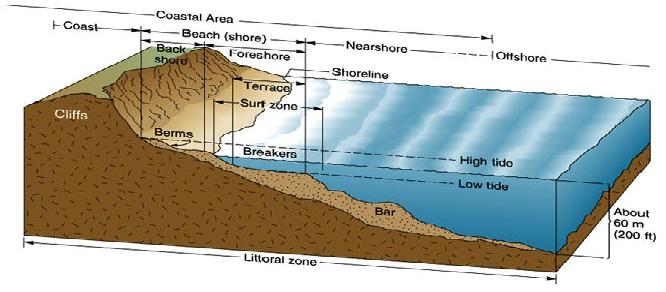
Species within the genus Conus are predatory and venomous capable of stinging humans.
While the focal prey of Conus ebraeus are eunicid polychaetes (i.e., members of the genus Palola) at most locations in the Indo-West Pacific (e.g., the Maldives, eastern Indian Ocean, Great Barrier Reef, Okinawa and Guam), at Hawaii and the Seychelles this species predominantly preys on nereid polychaetes. These results suggest that Conus ebraeus exhibits geographic variation in dietary specialization.Scientific classification
Domain: Eukaryota
Kingdom: Animalia
Phylum: Mollusca
Class: Gastropoda
Subclass: Caenogastropoda
Order: Neogastropoda
Superfamily: Conoidea
Family: Conidae
Genus: Conus
Species: Conus ebraeus
Binomial name: Conus ebraeus
Linnaeus, 1758
(REF:Linnaeus, C. (1758). Systema Naturae per regna tria naturae, secundum classes, ordines, genera, species, cum characteribus, differentiis, synonymis, locis. Editio decima, reformata. Laurentius Salvius: Holmiae. ii, 824 pp Archived 2017-06-13 at the Wayback Machine )(REF: Linnaeus C. (1758). Systema Naturae, 10th ed., 1 )(REF: Tryon G. W. (1884). Manual of Conchology, structural and systematic, with illustrations of the species. Volume 6. Conidae,)(REF: Jiménez-Tenorio, Manuel. (2016). Cone radular anatomy as a proxy for phylogeny. DOI:10.13140/RG.2.1.2961.8803.)(REF: The United States Navy divides littoral regions into several zones. From https://ile-lms-adp.nko.navy.mil/cnet/customcontent/content/primary_pro_mil_education/PPME_JO/Primary_PME_R4_V08/Primary_PME_V44_THINKS/Naval_Warfare/C2_Naval_Forces/CWC_Conc)
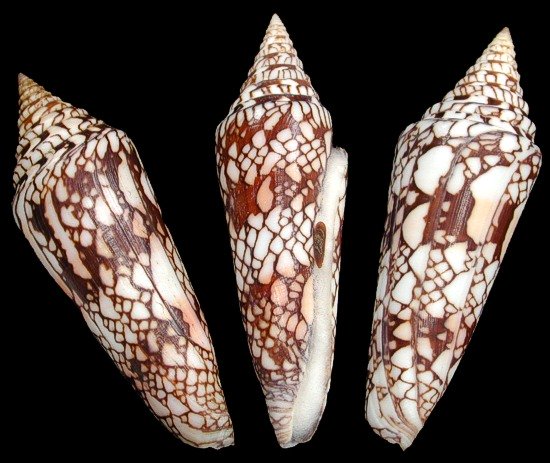
Conus Milneedwardsi
Commnon name "Glory of India", is a species of sea snail, a marine gastropod mollusk in the family Conidae, the cone snails>
These snails are predatory, venomous and capable of stinging humans.
The size of an adult shell averages between 1 3/4 to 7 1/2 inches. The Milneedwardsi shell is thin and slende with a smooth surface, an acuminate Spire and an angulate shoulder. The color of the shell is white with two chocolate spiral bands on the body whorl. This body whorl shows a pattern of axial reddish brown reticulated lines forming white triangles or quadrangular markings.
Acuminate is an adjective that means tapering to a slender point.
angulate: forming an angle; when two margins meet in an angle.
The Milneedwardsi species are found off Madagascar, off the African coast from KwaZulu-Natal, South Africa, to the Red Sea; in the China Sea and in the Indian Ocean off Bombay.
Scientific classification
Domain: Eukaryota
Kingdom: Animalia
Phylum: Mollusca
Class: Gastropoda
Subclass: Caenogastropoda
Order: Neogastropoda
Superfamily: Conoidea
Family: Conidae
Genus: Conus
Species: Conus milneedwardsi
Binomial name: Conus milneedwardsi
Jousseaume, 1894
(REF: Conus milneedwardsi Jousseaume, 1894. Retrieved through: World Register of Marine Species )(REF: Schmidt, W. & O. Bellec (1994). Findings of some uncommon sea-shells off Madagascar. African Journal of Tropical Hydrobiology and Fisheries)(REF:Filmer R.M. (2001). A Catalogue of Nomenclature and Taxonomy in the Living Conidae 1758 – 1998. Backhuys Publishers, Leiden. )(REF: Tucker J.K. (2009). Recent cone species database. September 4, 2009 Edition)
Z0-17
One Conus Milneedwardsi, measuring 4 to 4.5 inches......$60.59
Z1-17
One Conus Milneedwardsi shell measuring 4.5 to 4.75 inches......$74.59
Z2-17
One Conus Milneedwardsi shell, measuring 4 3/4 to 5 inches......$88.59
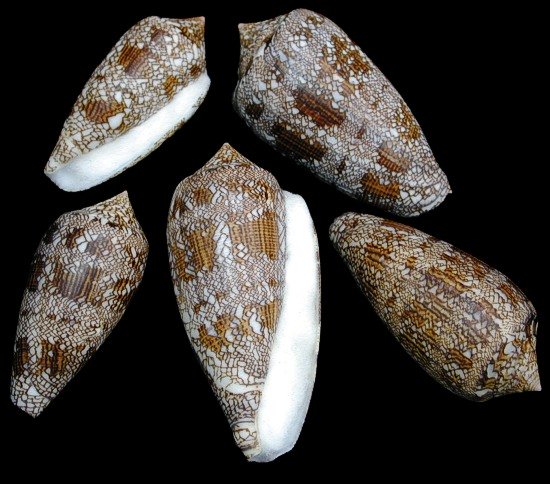
Conus Textile
W1-3
A Conus Textile shell measuring 2 to 3 inches..... $5.15
W2-3
A Textile Cone shell measuring 3 to 4 inches .......$5.45
The textile cone its common name, cloth of gold cone is a venomous species of sea snail, a marine gastropod mollusk in the family Conidae, the cone snails, cone shells or cones. Textile cone snails live mostly in the Indian Ocean, along the eastern coast of Africa and across the shores of Australia.
The Textile cone are predatory and venomous. They have been known to sting humans, live ones should be handled carefully or not at all. Based on a report in 2004, about 30 human deaths were attributed to cone snail stings.
The average length of adult textile cones is about 3 1/2 to 4 inches. The maximum shell length for this species is about 6 inches. The color of the shell is yellowish brown, with undulating longitudinal lines of chocolate, interrupted by triangular white spaces. These last are irregularly disposed, but crowded at the shoulder, base and middle so as to form bands. The spire is similarly marked. The aperture is white.
A spire is a part of the coiled shell of molluscs. The spire consists of all of the whorls except for the body whorl. Each spire whorl represents a rotation of 360°.
The aperture is an opening in certain kinds of mollusc shells: it is the main opening of the shell, where the head-foot part of the body of the animal emerges for locomotion, feeding, etc
The female textile cone lays several hundred eggs at a time, which hatch after about 16 or 17 days. After hatching, the larvae float around in the current for approximately 16 days. Afterward, they settle at the bottom of the ocean. By this point their length is about 1/4 inch.
Textile Cones are a carnivorous species, and use a radula (a biological microscopic needle) to inject a conotoxin to kill its prey. The preferred prey are snails. The proboscis, the tip of which holds the harpoon-like radular tooth, is capable of being extended to any part of its own shell. The living animal is a risk to any person handling it who has not taken proper care to protect exposed skin. Several human deaths have been attributed to this species.
The radula is an anatomical structure used by mollusks for feeding, sometimes compared to a tongue. It is a minutely toothed, chitinous ribbon, which is typically used for scraping or cutting food before the food enters the esophagus. The radula is unique to the mollusks, and is found in every class of mollusk except the bivalves, which instead use cilia, waving filaments that bring minute organisms to the mouth.A conotoxin is one of a group of neurotoxic peptides isolated from the venom of the marine cone snail, genus Conus. Neurotoxicity is a form of toxicity in which a biological, chemical, or physical agent produces an adverse effect on the structure or function of the central and/or peripheral nervous system.
A proboscis is an elongated appendage from the head of an animal, either a vertebrate or an invertebrate. In invertebrates (Textile Cones), the term usually refers to tubular mouthparts used for feeding and sucking. In vertebrates, a proboscis is an elongated nose or snout.
Scientific classification
Domain: Eukaryota
Kingdom: Animalia
Phylum: Mollusca
Class: Gastropoda
Subclass: Caenogastropoda
Order: Neogastropoda
Superfamily: Conoidea
Family: Conidae
Genus: Conus
Species: Conus textile
Binomial name: Conus textile
Linnaeus, 1758
(REF: Duda, T. (2013). "Conus textile". IUCN Red List of Threatened Species. 2013: e.T192316A2071675. doi:10.2305/IUCN.UK.2013-1.RLTS.T192316A2071675.en)(REF: "World Register of Marine Species". Conus textile Linnaeus, 1758. 2009 )(REF: "Conus textile". Archived from the original on July 17, 2003. Retrieved August 19, 2016)(REF: Peters, Howard; O'Leary, Bethan C.; Hawkins, Julie P.; Carpenter, Kent E.; Roberts, Callum M. (2013-12-23). "Conus: First Comprehensive Conservation Red List Assessment of a Marine Gastropod Mollusc Genus". PLOS ONE. 8 (12)(REF: Poutiers, J. M. (1998). "Gastropods". In Carpenter, K. E. (ed.). The living marine resources of the Western Central Pacific (PDF). FAO Species Identification Guide for Fishery Purposes. Vol. 1. Rome)(REF: Stephen Coombes (February 2009). "The Geometry and Pigmentation of Seashells)(REF:George Washington Tryon, Manual of Conchology vol. VI )(REF: Online Learning Center: Textile Cone Snail". Aquarium of the Pacific. Archived from the original on 2012-02-07)(REF: Conus textile Linnaeus, 1758. Textile cone, )
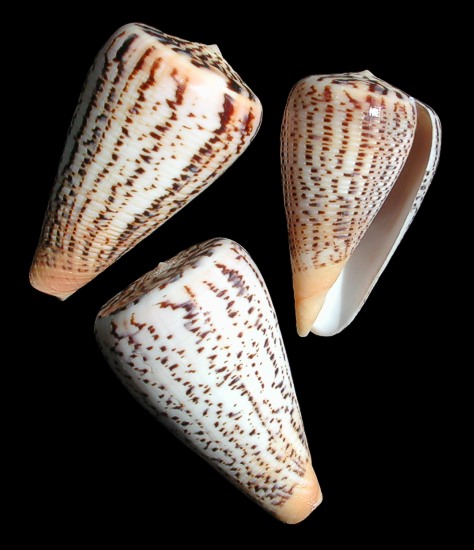
Conus suratensis
SC00-865
A single Conus Suratensis shell, measuring between 1.5 to 2 inches....... $6.99
SC01-865
SC02-865
A Conus Suratensis shell measuring 3 to 4 inches......$7.95
SCO3-865
One Conus Suratensis shell measuring at least 4 inches .......OUT OF STOCK
<Conus Suratensis common name is the Surat cone. These are a species of sea snails, a marine gastropod mollusk in the family Conidae.
This species is in the genus Conus, which are predatory and venomous. They are capable of stinging humans and live ones should be handled carefully or not at all.
The average shell size varies between 1 1/2 to 6 inches. Its color ranges between yellow or orange-brown, with revolving series of numerous spots, and short lines of chocolate upon narrow white bands. The more rugose (wrinkled) growth lines cause them to be regularly interrupted, so that they form longitudinal as well as revolving series. The spire is radiated with chocolate. The base of the shell is strongly grooved.
The Suratensis Cone shells are found in the Indo-Pacific off the Andaman and Nicobar Islands, in the Andaman Sea, off Bangladesh, in the Bay of Bengal, off Eastern Indi, off Indo-Malaysia, off Madagascar, off Myanmar (Burma), off the Solomon Islands, off Sri Lanka, off Thailand and off Australia (Queensland).
Scientific classification
Domain: Eukaryota
Kingdom: Animalia
Phylum: Mollusca
Class: Gastropoda
Subclass: Caenogastropoda
Order: Neogastropoda
Superfamily: Conoidea
Family: Conidae
Genus: Conus
Species: Conus suratensis
Binomial name: Conus suratensis
Hwass in Bruguière, 1792
(REF:Conus suratensis Hwass in Bruguière, 1792. Retrieved through: World Register of Marine Species )(REF: G.W. Tryon (1884) Manual of Conchology, structural and systematic, with illustrations of the species, vol. VI; Philadelphia, Academy of Natural Sciences (described as Conus betulinus var. suratensis)(REF: Cernohorsky, W.O. 1978. Tropical Pacific Marine Shells. Sydney : Pacific Publications 352)(REF:Bruguière, J. G., and Hwass, C. H., 1792. Cone. Encyclopédie Méthodique: Histoire Naturelle des Vers, 1: 586 -757 )
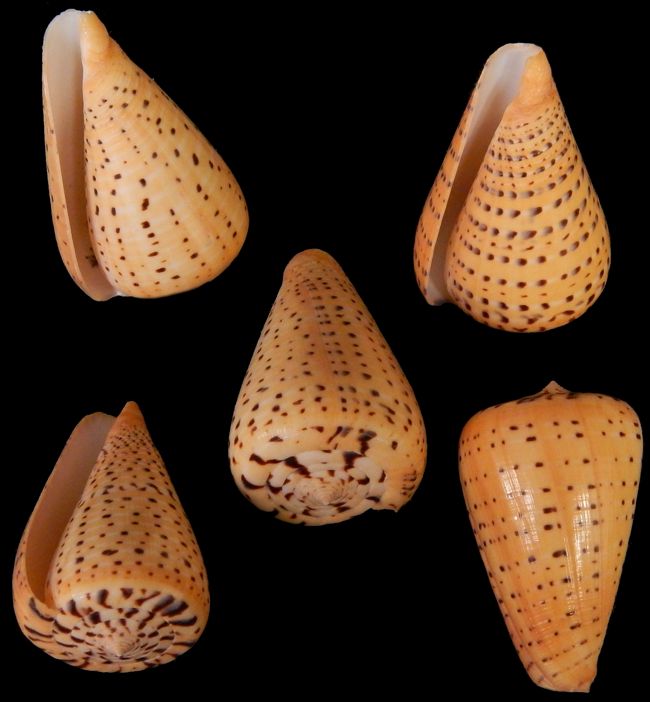
Conus Betulinus
W2-17
Three Conus Bitulinus shell, measuring between 2 and 3 inches......... $5.25
Conus Betulinus common name is the betuline cone.
They are a species of sea snail, a marine gastropod mollusk in the family Conidae, the cone snails.
These snails like other cohe shells are predatory and venomous, living specimens are capable of stinging humans.
The Bitulinus shell average size varies between 1.5 and 6.5 inches. The color of the shell ranges between yellow orange-brown, to white, with revolving series of spots, and short lines of chocolate upon narrow white bands. The spire is radiated with chocolate. The base of the shell is strongly grooved.
The Bitulinus cone dwell across the Indo-Pacitic and Indo-China region. They have been found in the inter tidal zone to depths of 65 feet.
Scientific classification
Domain: Eukaryota
Kingdom: Animalia
Phylum: Mollusca
Class: GastropodaSubclass: Caenogastropoda
Order: Neogastropoda
Superfamily: Conoidea
Family: Conidae
Genus: Conus
Species: Conus betulinus
Binomial name: Conus Betulinus
Linnaeus, 1758
(REF: Kohn, A. (2013). "Conus betulinus". IUCN Red List of Threatened Species. 2013:)(REF: Conus betulinus Linnaeus, 1758. Retrieved through: World Register of Marine Species 2010)(REF: G.W. Tryon (1884) Manual of Conchology, structural and systematic, with illustrations of the species, vol. VI; Philadelphia, Academy of Natural Sciences)